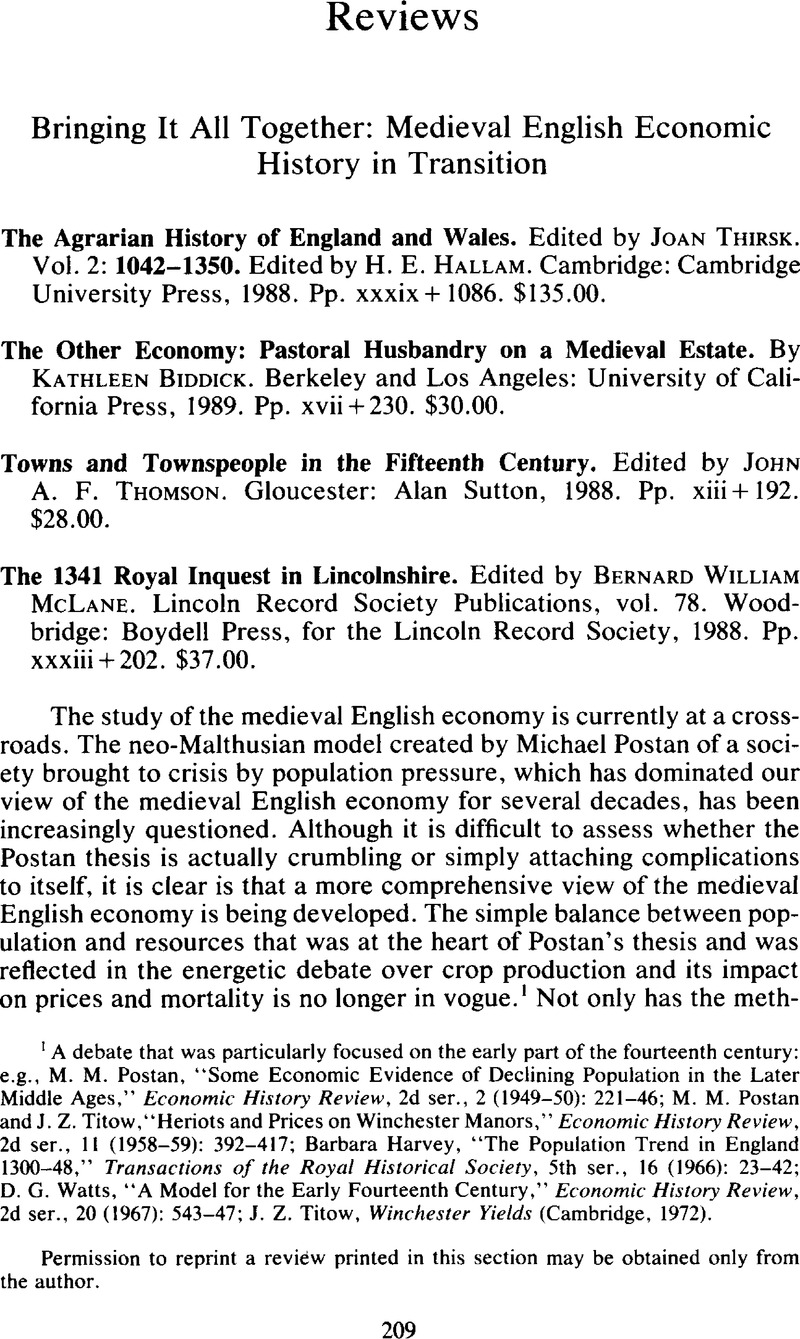Article contents
Bringing It All Together: Medieval English Economic History in Transition - The Agrarian History of England and Wales. Edited by Joan Thirsk. Vol. 2: 1042–1350. Edited by H. E. Hallam. Cambridge: Cambridge University Press, 1988. Pp. xxxix + 1086. $135.00. - The Other Economy: Pastoral Husbandry on a Medieval Estate. By Kathleen Biddick. Berkeley and Los Angeles: University of California Press, 1989. Pp. xvii + 230. $30.00. - Towns and Townspeople in the Fifteenth Century. Edited by John A. F. Thomson. Gloucester: Alan Sutton, 1988. Pp. xiii + 192. $28.00. - The 1341 Royal Inquest in Lincolnshire. Edited by Bernard William McLane. Lincoln Record Society Publications, vol. 78. Woodbridge: Boydell Press, for the Lincoln Record Society, 1988. Pp. xxxiii + 202. $37.00.
Published online by Cambridge University Press: 10 January 2014
Abstract

- Type
- Reviews
- Information
- Copyright
- Copyright © North American Conference of British Studies 1991
References
Permission to reprint a review printed in this section may be obtained only from the author.
1 A debate that was particularly focused on the early part of the fourteenth century: e.g., Postan, M. M., “Some Economic Evidence of Declining Population in the Later Middle Ages,” Economic History Review, 2d ser., 2 (1949–1950): 221–46CrossRefGoogle Scholar; Postan, M. M. and Titow, J. Z., “Heriots and Prices on Winchester Manors,” Economic History Review, 2d ser., 11 (1958–1959): 392–417CrossRefGoogle Scholar; Harvey, Barbara, “The Population Trend in England 1300–48,” Transactions of the Royal Historical Society, 5th ser., 16 (1966): 23–42CrossRefGoogle Scholar; Watts, D. G., “A Model for the Early Fourteenth Century,” Economic History Review, 2d ser., 20 (1967): 543–47CrossRefGoogle Scholar; Titow, J. Z., Winchester Yields (Cambridge, 1972)Google Scholar.
2 Campbell, B. M. S., “Agricultural Productivity in Medieval England: Some Evidence from Norfolk,” Journal of Economic History 48 (1983): 379–404CrossRefGoogle Scholar.
3 Postan, M. M., The Medieval Economy and Society (Harmondsworth, 1975), esp. chap. 12Google Scholar.
4 Campbell, Bruce M. S. and Power, John P., “Mapping the Agricultural Geography of Medieval England,” Journal of Historical Geography 15 (1989): 24–39CrossRefGoogle Scholar.
5 Campbell, Bruce M. S., “Towards an Agricultural Geography of Medieval England,” Agricultural History Review 36 (1988): 87–98Google Scholar; Langdon, John, Horses, Oxen and Technological Innovation (Cambridge, 1986), pp. 273–76Google Scholar; Hare, John N., “Change and Continuity in Wiltshire Agriculture: The Later Middle Ages,” in Agricultural Improvement: Medieval and Modern, ed. Minchinton, W. A., Exeter Papers in Economic History, no. 14 (Exeter, 1981), pp. 1–18Google Scholar.
6 For example, Hatcher, J., Plague, Population and the English Economy, 1348–1530 (London, 1977)CrossRefGoogle Scholar; Gottfried, R. S., Epidemic Disease in Fifteenth-Century England (New Brunswick, N.J., 1978)Google Scholar; Lamb, H. H., Climate: Present, Past and Future (London, 1977)Google Scholar; Parry, M. L., Climatic Change, Agriculture and Settlement (Folkestone, 1978)Google Scholar; Prestwich, M., Politics, War and Finance under Edward I (London, 1972)Google Scholar; Maddicott, J. R., “The English Peasantry and the Demands of the Crown, 1294–1341” in Landlords, Peasants and Politics in Medieval England, ed. Aston, T. H. (Cambridge, 1987Google Scholar; originally published as a Past and Present supplement in 1975); Spufford, Peter, Money and Its Use in Medieval Europe (Cambridge, 1988)CrossRefGoogle Scholar; Langdon; Holt, Richard, The Mills of Medieval England (Oxford, 1988)Google Scholar.
7 Marketing, however, is to be covered for the period in volume 3, soon to be published.
8 Campbell, B. M. S., “Agricultural Progress in Medieval England: Some Evidence from Eastern Norfolk,” Economic History Review, 2d ser., 36 (1983): 26–46CrossRefGoogle Scholar; Brandon, P. F., “Demesne Arable Farming in Coastal Sussex during the Later Middle Ages,” Agricultural History Review 19 (1971): 113–34Google Scholar.
9 For example, Sawyer, P. H., ed., Domesday Book: A Reassessment (London, 1985)Google Scholar; McDonald, John and Snooks, G. D., Domesday Economy: A New Approach to Anglo-Norman History (Oxford, 1986)CrossRefGoogle Scholar; Holt, J. C., ed., Domesday Studies (Woodbridge, Suffolk, 1987)Google Scholar.
10 Langdon, esp. pp. 291–92; Campbell, Bruce, “The Diffusion of Vetches in Medieval England,” Economic History Review, 2d ser., 41 (1988): 204–5CrossRefGoogle Scholar; Dyer, C. C., “Warwickshire Farming, 1349–C.1520: Preparations for Agricultural Revolution,” Dugdale Society Occasional Papers, no. 27 (1981): 22–34Google Scholar; Watkins, Andrew, “Cattle Grazing in the Forest of Arden in the Later Middle Ages,” Agricultural History Review 37 (1989): 18–20, 22–23Google Scholar.
11 For example, Campbell, “Agricultural Progress in Medieval England.”
12 Dyer, pp. 17–18; Watkins, pp. 17–18.
13 Maddicott.
14 Ibid., pp. 301, 318. 338.
15 For example, in 1338 Thomas Dunstable was ordered to collect just under eight thousand quarters of grains and malts from seventeen counties, including Lincolnshire (p. xii). This would have consumed the crops from ten to fifteen square miles of land, a tiny fraction of the crop acreage in the counties concerned.
16 We are more familiar with the last in the Anglo-Saxon period, thanks to the work of Richard Hodges, but the approach is also beginning to penetrate the later period: e.g., Biddick, Kathleen, “People and Things: Power in Early English Development,” Comparative Studies in Society and History 32 (1990): 3–23CrossRefGoogle Scholar.
- 1
- Cited by




